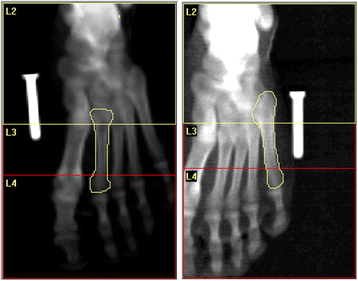Reliability of analysis of the bone mineral density of the second and fifth metatarsals using dual-energy x-ray absorptiometry (DXA)
- PMID: 29209416
- PMCID: PMC5704601
- DOI: 10.1186/s13047-017-0234-1
Reliability of analysis of the bone mineral density of the second and fifth metatarsals using dual-energy x-ray absorptiometry (DXA)
Abstract
Background: Metatarsal fractures, especially of the fifth metatarsal, are common injuries of the foot in a young athletic population, but the risk factors for this injury are not well understood. Dual-energy x-ray absorptiometry (DXA) provides reliable measures of regional bone mineral density to predict fracture risk in the hip and lumbar spine. Recently, sub-regional metatarsal reliability was established in fresh cadaveric specimens and associated with ultimate fracture force. The purpose of this study was to assess the reliability of DXA bone mineral density measurements of sub-regions of the second and fifth metatarsals in a young, active population.
Methods: Thirty two recreationally active individuals participated in the study, and the bone density of the second (2MT) and fifth (5MT) metatarsals of each subject was measured using a Hologic QDR x-ray bone densitometer. Scans were analyzed separately by two raters, and regional bone mineral density, bone mineral content, and area measurements were calculated for the proximal, shaft, and distal regions of the bone. Intra-rater, inter-rater, and scan-rescan reliability were then determined for each region.
Results: Proximal and shaft bone mineral density measurements of the second and fifth metatarsal were reliable. ICC's were variable across regions and metatarsals, with the distal region being the poorest.
Conclusions: Bone mineral density measurements of the metatarsals may be a better indicator of fracture risk of the metatarsals than whole body measurements. A reliable method for measuring the regional bone mineral densities of the metatarsals was found. However, inter-rater reliability and scan-rescan reliability for the distal regions were poor. Future research should examine the relationship between DXA bone mineral density measurements and fracture risk at the metatarsals.
Keywords: Bone health; Bone mineral density; Dual x-ray absorptiometry; Foot; Metatarsals; Stress fracture.
Conflict of interest statement
Authors’ information
Not applicable
Ethics approval and consent to participate
Participants signed a consent form to participate in the research study that was approved by High Point University IRB.
Consent for publication
Not applicable
Competing interests
The authors declare that they have no competing interests.
Publisher’s Note
Springer Nature remains neutral with regard to jurisdictional claims in published maps and institutional affiliations.
Figures
References
MeSH terms
LinkOut - more resources
Full Text Sources
Other Literature Sources
Medical


